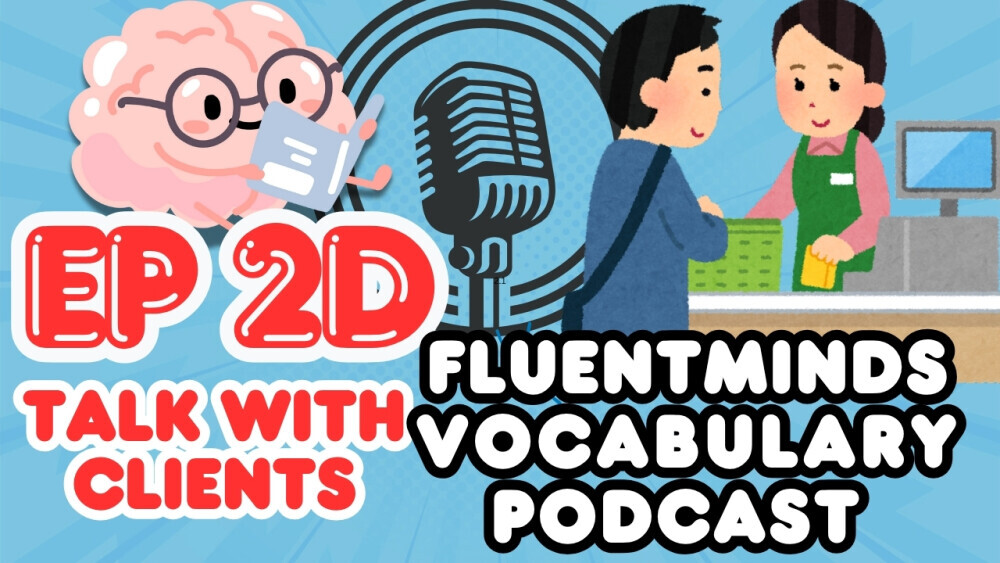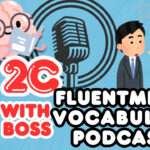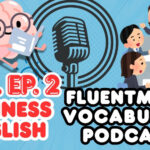Top English Phrases for Talking to Clients Naturally – FluentMinds-Episode-2D-Full-Script
🎧 Welcome back to the FluentMinds Podcast — your space to master real English for real situations. In Episode 2D, we’re diving into one of the most high-pressure communication skills in business: how to talk to clients professionally — but naturally.
Whether you work in tech, sales, design, or customer service, dealing with clients means staying calm, clear, and credible — even when you’re not sure what to say.
In this episode, Alex and Sam walk through 4 essential English phrases used by real professionals in real client interactions. You’ll learn:
FluentMinds-Episode-2D-Worksheet
- The best phrase to use when you’re not 100% sure of the answer
- How to sound flexible and accommodating without overcommitting
- How to clarify feedback without sounding defensive
- What to say when a client finds a mistake — and how to stay professional
You’ll also practice the intonation, stress, and linking sounds that make these phrases sound fluent, not forced.
🧠 Featured Phrases from Episode 2D
1. “Let me double-check and get back to you.”
Used when you don’t have all the info. It shows professionalism and responsibility.
Variations:
- “I’ll look into that and follow up shortly.”
- “Let me confirm and circle back to you.”
2. “What would work best for you?”
Great for scheduling or offering options. It keeps the tone collaborative.
Variations:
- “What’s most convenient on your end?”
- “Would you prefer Thursday or Friday?”
3. “Just to clarify…”
Use this to avoid confusion without sounding confrontational.
Variations:
- “So just to make sure we’re on the same page…”
- “Let me make sure I’ve understood correctly…”
4. “Thanks for flagging that.”
Responds to feedback or errors with professionalism.
Variations:
- “I appreciate you bringing that to my attention.”
- “Good catch — I’ll take care of it.”
🔄 Synonym Phrases You Can Also Use:
- “Let me check on that and circle back.”
- “Would it help if I sent you a quick recap?”
- “Let me know if I’ve missed anything.”
- “Thanks for pointing that out.”
These options help you adjust tone depending on the context: casual, formal, urgent, or diplomatic.
🎯 Pronunciation & Intonation Tips
Many learners struggle with sounding too robotic or unsure when speaking to clients. Here’s what we practiced in the episode:
- Link your words: “Just to clarify” → “Justa clarify”
- Stress key words: “get BACK to you”
- Reduce filler sounds: “would you” → “wuh-joo”
- End firm but friendly: drop tone slightly on key ideas
🧩 Why This Matters for Your English
In client interactions, tone is everything. You want to:
- Be confident, but not aggressive
- Be flexible, but not passive
- Be precise, but not robotic
This episode helps you: ✅ Handle unexpected client questions ✅ Sound natural under pressure ✅ Respond to feedback with maturity ✅ Build real-world fluency — not textbook phrases
🎙️ Mini Dialogue Practice
Alex: What if a client gives you vague feedback?
Sam: I’d say, “Just to clarify, you mean the new version of the file?”
Alex: Nice. But smoother — try “Justa clarify…”
Sam: Justa clarify, you mean the new version of the file?
Alex: That’s it. Fluent and professional.
📥 Download Your Practice Materials
FluentMinds-Episode-2D-Full-Script
FluentMinds-Episode-2D-Worksheet
These include:
- A vocabulary cheat sheet
- Pronunciation and linking drills
- 3 written exercises to reinforce what you learned
💬 Which phrase do YOU plan to use with your clients? Let us know in the comments — and tell us what situations you struggle with most.
🔜 What’s Next? In Episode 3A, we’re moving to one of the most in-demand topics for professionals: How to master job interviews in English.
You’ll learn how to:
- Talk about your experience without rambling
- Answer tricky questions with confidence
- Sound natural, not rehearsed
Don’t miss it. Set your reminder now.
💡 Fluent doesn’t mean perfect — it means effective.
🎧 Listen to all episodes on YouTube, Spotify, or wherever you get your podcasts.
FluentMinds-Episode-2D-Full-Script
Top English Phrases for Talking to Clients Naturally – FluentMinds Podcast Ep 2D
[Alex – calm, confident tone]
Ever freeze up when talking to a client?
No script. No time to think. Just… pressure?
Good. You’re in the right place.
This episode will give you the exact phrases that fluent professionals use when responding to client requests, setting expectations, Let’s do it — Episode 2D of the FluentMinds Podcast starts now.
n Phrase 1: “Let me double-check and get back to you.”
[Alex]
Here’s the situation: A client asks a question — but you’re not 100% sure.
Don’t guess.
Don’t freeze.
Say this instead:
n “Let me double-check and get back to you.”
You’re being careful, clear, and professional. You’re not ignoring them — you’re just giving yourself room to answer properly.
[Sam]
“Let me double-check and get back to you.”
[Alex]
Now say it with rhythm — not robotic:
n “Lemme double-check… and get BACK to you.”
[Sam]
“Lemme double-check… and get BACK to you.”
[Alex]
Perfect. You sound responsible — not rushed.
Try these, too:
n “I’ll look into that and follow up shortly.”
n “Let me confirm and circle back to you.”
n Phrase 2: “What would work best for you?”
[Alex]
Next: You’re scheduling, offering options, or trying to be flexible.
The best move? Put the ball in their court.
n “What would work best for you?”
It’s polite. It’s smooth. It’s pro-level collaboration.
[Sam]
“What would work best for you?”
[Alex]
Now reduce the “would” and say it with flow:
n “Whawuh work best for you?”
[Sam]
“Whawuh work best for you?”
[Alex]
Nice. You sound client-friendly — not robotic.
Let’s try some natural alternatives:
n “What’s most convenient on your end?”
n “Would you prefer Thursday or Friday?”
n Phrase 3: “Just to clarify…”
[Alex]
Let’s say a client gives you feedback… but it’s vague.
You don’t want to assume. You don’t want to guess.
You need clarity — without sounding defensive.
n “Just to clarify…”
[Sam]
“Just to clarify, you mean the new version of the file?”
[Alex]
Great. But now connect it more:
n “Justa clarify…” (all one breath — don’t punch the “to”)
[Sam]
“Justa clarify, you mean the new version of the file?”
[Alex]
Perfect. Try these too:
n “So just to make sure we’re on the same page…”
n “Let me make sure I’ve understood correctly…”
n Phrase 4: “Thanks for flagging that.”
[Alex]
And finally — appreciation.
A client points out an error or gives feedback.
This phrase keeps you professional, even when something went wrong.
n “Thanks for flagging that.”
[Sam]
“Thanks for flagging that — I’ll get on it right away.”
[Alex]
Now give it some tone:
n Drop slightly on “that” — don’t let it sound sarcastic.
[Sam]
“Thanks for flagging that.”
[Alex]
Nice. You’re owning it.
Try these too:
n “I appreciate you bringing that to my attention.”
n “Good catch — I’ll take care of it.”
n Quick Recap — Say it with us
[Alex & Sam together]
“Let me double-check and get back to you.”
“What would work best for you?”
“Just to clarify…”
“Thanks for flagging that.”
[Alex]
You sound fluent — because you’re acting fluent.
This episode isn’t just about phrases — it’s about mindset.
Talk like a pro. Own your message. Be the kind of communicator clients remember — for all the right reasons.
n Next Time…
In Episode 3A, we’ll show you how to master job interviews in English — from self-introductions to confident answers.
Until then, remember:
n Fluent doesn’t mean perfect — it means effective.
FluentMinds-Episode-2D-Worksheet
Key Phrases to Remember
– Let me double-check and get back to you.
– What would work best for you?
– Just to clarify…
– Thanks for flagging that.
Exercise 1: Fill in the Blanks
– Let me ________ and get back to you.
– What would ________ best for you?
– Just to ________…
– Thanks for ________ that.
Exercise 2: Rewrite with a More Professional Tone
– I don’t know right now.
– When can you do it?
– What are you saying?
– You made a mistake.
Exercise 3: Match the Meaning
– A. Let me double-check and get back to you.
– B. What would work best for you?
– C. Just to clarify…
– D. Thanks for flagging that.
–
– – You want to confirm something before replying.
– – You’re offering options politely.
– – You’re making sure you understood.
– – You’re acknowledging helpful feedback.


